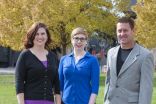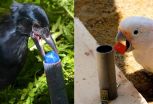(Press-News.org) By blocking a widespread enzyme, Centenary researchers have shown they can slow down the movement of cells and potentially stop tumours from spreading and growing.
Using a new super-resolution microscope they've been able to see single molecules of the enzyme at work in a liver cancer cell line. Then they've used confocal microscopes to see how disrupting the enzyme slows down living cancer cells.
The enzyme is DPP9 (dipeptidyl peptidase 9) which the researchers at the Centenary Institute and the Sydney Medical School were first to discover and clone, in 1999. Ever since they've been studying what it does, with a view to its possible use as a cancer drug target.
"It was exciting to be able to watch the enzyme at work and then block DPP9, and see the cells slow down," says A/Prof Mark Gorrell from Centenary's Molecular Hepatology unit. "This gives us our clearest evidence yet that this enzyme will be a good cancer drug target."
"What this work has shown us is that this enzyme is absolutely critical to cell movement, and without cell movement, tumors can't grow or spread," says Gorrell of the work, published in the the leading European cell biology journal BBA Molecular Cell Research.
Using the recently acquired super-resolution microscope, Ms Hui (Emma) Zhang--one of Gorrell's PhD students--determined where individual fluorescently tagged DPP9 molecules were located inside cells. She found that DPP9 lies on the microtubules that play a significant role in intracellular transport and in cell migration.
When cells were stimulated to move, Zhang discovered DPP9 accumulates at the leading edge of the moving cell. DPP9 was also associated with the adhesion protein complex that glues the cell to the external matrix though which it moves, acting as an anchor point to pull the cell along. When the action of DPP9 was inhibited in cells, such movement and adhesion diminished.
"DPP9 is looking more and more like a cancer drug target. But at present we have no specific inhibitors for it, even though chemists have been trying for some years to make one." he said. "We need to throw more resources at this problem."
During the past 15 years, Gorrell has been unveiling the properties of DPP9, which belongs to a small family of four enzymes specialised in cleaving other proteins. Members of this family modify and regulate proteins for many important functions inside and outside of cells. DPP4, for instance, is already the basis of a leading drug treatment for diabetes. DPP4 inhibitors are worth about $6 billion a year and comprise about a quarter of the diabetes drug market.
"The roadblock to developing a specific inhibitor for DPP9 has been that it is very similar physically, but not functionally, to DPP8. It has been hard to distinguish between the two chemically," Gorrell says. He is now working on determining and publishing differences between the two enzymes, which should help chemists target their efforts better.
"This is our first paper to be generated using this new microscope, which we acquired in collaboration with Sydney University with the help of the Ramaciotti Foundation," the Executive Director of the Centenary Institute, Prof Mathew Vadas AO says. "It is a great illustration of the value of the latest microscope imaging technologies to medical research."
INFORMATION:
Full release, backgrounder, photos and video at: http://www.centenary.org.au/p/p/about/media/mediareleases/2014/12/cancer-cant-grow
For interviews and more information:
Toni Stevens, Science in Public on +61401763130 or toni@scienceinpublic.com.au or
Mark Gorrell, Molecular Hepatology unit, Centenary Institute on +61419933474 or m.gorrell@centenary.org.au
Serena Stewart, Centenary Institute on +61466166878 or s.stewart@centenary.org.au
Tropical Cyclone Bakung is moving in a westerly direction over the open waters of the Southern Indian Ocean and NASA's Aqua satellite captured an image of the sea storm.
Aqua passed over Bakung on Dec. 12 at 07:35 UTC (2:35 a.m. EST) and the MODIS instrument aboard took a visible image of the storm. The image showed that deeper convection (stronger currents of rising air that form the thunderstorms that make up the tropical cyclone) was occurring around the low-level center of circulation, so the center was not apparent in the MODIS imagery. The bulk of the clouds associated ...
Natural gas from hydraulic fracturing generates income and, done well, can reduce greenhouse gas emissions, air pollution and water use compared to coal and even nuclear energy. However, widespread use of natural gas from fracking could slow the adoption of wind, solar and other renewables and, done poorly, release toxic chemicals into the environment.
Robert Jackson, the Kevin and Michelle Douglas Professor of Environment and Energy at the Stanford School of Earth Sciences, will discuss how to minimize the water and air impacts of fracking and other unconventional energy-extraction ...
Recent international climate talks have focused on the potential of reforestation and afforestation - planting trees in an area where there was no forest previously - to slow global warming. Increasingly, though, science is showing that planting more trees and increasing forest conservation can provide benefits beyond carbon storage, and that carbon-centric accounting is, in many cases, insufficient for climate mitigation policies.
Robert Jackson, the Kevin and Michelle Douglas Professor of Environment and Energy at the Stanford School of Earth Sciences, will discuss ...
Runoff from rainstorms in big cities can represent both threats and opportunities. Too much runoff in the wrong places causes flooding. Too little rainwater in the right places leads to dried-up creeks and rivers. Water that washes up pollution from city streets can dirty downstream watersheds. Figuring out the best solutions to these problems requires lots of data - data that are easy to get in highly developed countries, but much scarcer in others.
On Dec. 15 at the American Geophysical Union Fall Meeting in San Francisco, Perrine Hamel, a postdoctoral scholar with ...
Stanford scientists have found evidence that sections of the fault responsible for the 9.0 magnitude Tohoku earthquake that devastated northern Japan in 2011 were relieving seismic stress at a gradually accelerating rate for years before the quake.
This "decoupling" process, in which the edges of two tectonic plates that are frictionally locked together slowly became unstuck, transferred stress to adjacent sections that were still locked. As a result, the quake, which was the most powerful ever recorded to hit Japan, may have occurred earlier than it might have otherwise, ...
WASHINGTON, Dec. 15, 2014--Credit card fraud and identify theft are serious problems for consumers and industries. Though corporations and individuals work to improve safeguards, it has become increasingly difficult to protect financial data and personal information from criminal activity. Fortunately, new insights into quantum physics may soon offer a solution.
As reported in The Optical Society's (OSA) new high-impact journal Optica, a team of researchers from the Netherlands has harnessed the power of quantum mechanics to create a fraud-proof method for authenticating ...
A survey of more than 300 college students reveals that college students who use "fake weed" or synthetic THC are most likely to have tried the drug because they were curious. Rebecca Vidourek, a University of Cincinnati assistant professor of health promotion and assistant director of the Center for Prevention Science; Keith King, a UC professor of health promotion and director of the Center for Prevention Science; and Michelle Burbage, a graduate student and graduate assistant for UC's Health Promotion and Education Program, published their findings in the current issue ...
This news release is available in French. "Media reports about behavioural genetics unintentionally induce unfounded beliefs, therefore going against the educational purpose of scientific reporting," writes the University of Montreal's Alexandre Morin-Chassé, following his study of 1,500 Americans. "Among other things, we wanted to know if the public understood (or misunderstood) popular science articles about a new research field, genopolitics, and whether this popularization indeed helped people have an informed opinion on human genetics," Morin-Chassé explained.
The ...
This news release is available in German. The ways animals play with inedible objects may be precursors of functional behaviors such as tool use and goal directed object manipulation. For these reasons, species of high technical intelligence are also expected to play intensely with inanimate objects when no obvious goal is pursued. Within object play, combinatory actions are considered a particularly informative trait in animals as well as human infants: Children start bashing two objects together when they are about 8 months old, at 10 months, they combine toys with ...
A study conducted by University of Granada scientists (from the Physiology, Obstetrics and Gynaecology Departments) and from the San Cecilio Clinical Hospital (Granada) has demonstrated that delaying the cutting of the umbilical cord in newborns by two minutes leads to a better development of the baby during the first days of life.
This multidisciplinary work, published in the prestigious journal Pediatrics reveals that the time in cutting the umbilical cord (also called umbilical cord clampling) influences the resistance to oxidative stress in newborns.
For this research, ...



